Meat Cleavers or just Cleavers are typically used by chefs and cooking enthusiasts for cutting tough meat, frozen food, soft bones, and joints. Be careful not to mistake them for Vegetable Cleavers though because they have similar shapes.
These special knives that look like small hatchets always come in handy in slasher movies and thrillers and are prioritised amongst chefs and butchers. A meat cleaver at home will transform your cooking tremendously by saving you prep time.
Although they’re invaluable in the kitchen, meat cleavers, fortunately, don’t come at a cost. Instead, they’re available to the average person for as low as $10 and no more than $1000 for the high-end vintage brands.
Table of Contents
A Brief History of the Antique Meat Cleaver
Sit back and read on as we unfold the untold history of antique meat cleavers
The chinese cleaver history of the antique meat cleaver
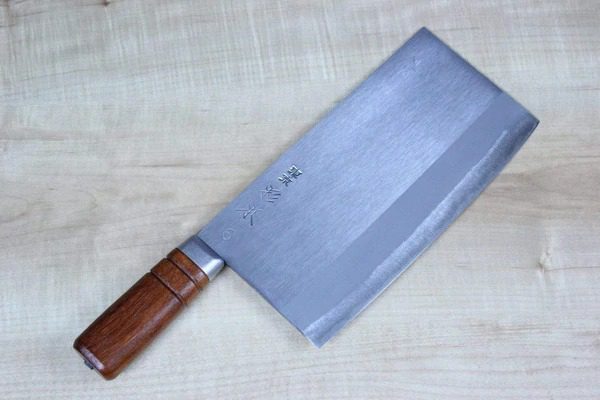
Chinese history places its existence further back up to 800,000 years ago in the time of the Lantian Men of Shaanxi. The cleaver shape started as a rock stone before thinning into a V-shape that entered the kitchen 4500 years ago.
By 1600 BC, during the reign of the Shang Dynasty, the stone rock meat cleavers switched to bronze blades. This Bronze era lasted until 221 BC, when the Qin Dynasty took over China. With the change in rulers came a kitchen overhaul which ushered in more structure.
In 202 BC, the Han Dynasty became the ruling house of China, and it accorded each kitchen knife a unique purpose. This era also birthed the iron smelters and consequently iron Meat Cleavers, which detailed the blade’s thickness, sharpness, and size.
Finally, the 618 AD Tang Dynasty separated the cleavers into meat and vegetable cutters based on their features.
Until the fall of the dynasties, meat cleavers were tools used in noblemen’s kitchens and not available to commoners hence the high value of antique meat cleavers.
Notice that the name tang, which refers to the meat cleaver’s edge, is similar to the Tang dynasty? Yes, to answer your inner question, they’re related.
The western history of the antique meat cleaver
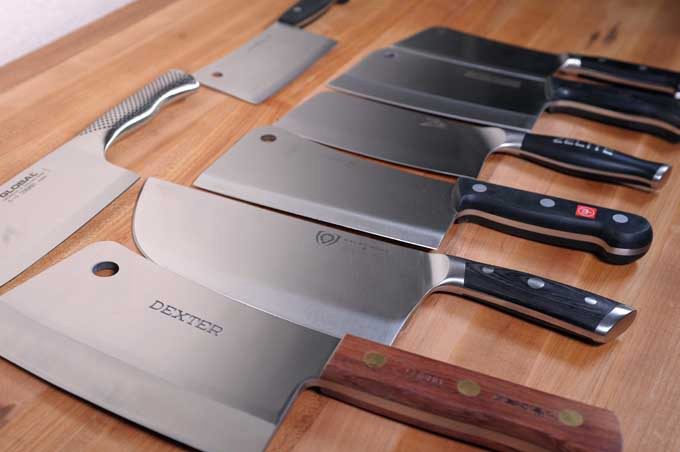
Western history says meat cleavers have been in existence since the 17th century during the French Acheulean period, albeit with a different spelling – Clever.
Even before then, mountain men used it as a staple tool for their daily activities, from killing games in the wild to meal prep and fighting.
They were part of the butcher knife collection, including carving forks and knives. However, an Englishman, John Wilson, was the first person to consider it as a commercial item. He sent the first branded pieces to America.
Common Types of Meat Cleavers
Meat cleavers can be grouped based on their design, production and region. Check out the types below.
Classification by Region
Japanese Meat Cleaver
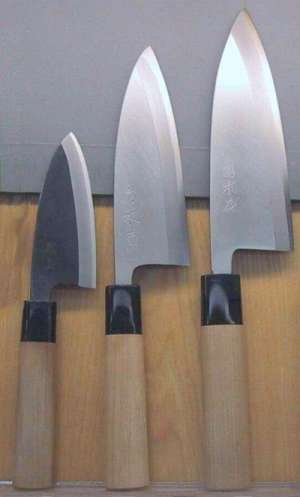
The Japanese meat cleaver, a.k.a. the Deba Bocho, comes in different sizes and has a partial tang attached to the hilt. However, because most Japanese food deals with fish, the Deba Bocho is now known as the fish knife.
Japanese meat cleavers started with carbon steel but graduated with stainless steel to improve maintenance and durability.
Chinese Meat Cleaver
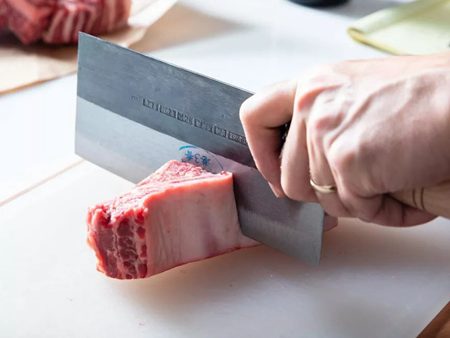
The Chinese meat cleaver is also known as the Gudao or Chinese Chef’s Knife because they use it for almost every meal. It often features a full tang making it heavier than the Western blade.
Gudao is famous for its sharpness, and that popularity has transcended its originating Asian shores. Other regions use the Chinese meat cleaver for non-traditional Asian meals, although it’s more common, especially in Sushi-making.
Classification by production
Forged Meat Cleaver
The meat cleaver is forged when the blade’s metal extends to its handle. This design takes more production time and is typically made of stainless steel.
Stamped Meat Cleaver
Unlike the forged steel, stamped meat cleavers take less time to produce since the manufacturing process is only a simple two-step. It takes cutting the metal sheets into a standard shape (hence the stamp) and fitting it into the hilt.
Essentially, stamped blades can’t withstand heavy-duty cuts for long as they’d rust and dissemble.
If you’re lucky, you can get a mixed production meat cleaver where the manufacturer assembles the pieces of stamped forged steel. They also make a reliable quality.
Prioritize the blade size over the handle size, especially if you’re into western and European cooking. However, if you’ll cook mostly fish like in Asian cuisine, look out for a Deba Bocho or long-handle meat cleaver.
Read the next ending to determine the difference between the tang edges.
Identification by Design (Tang Edge)
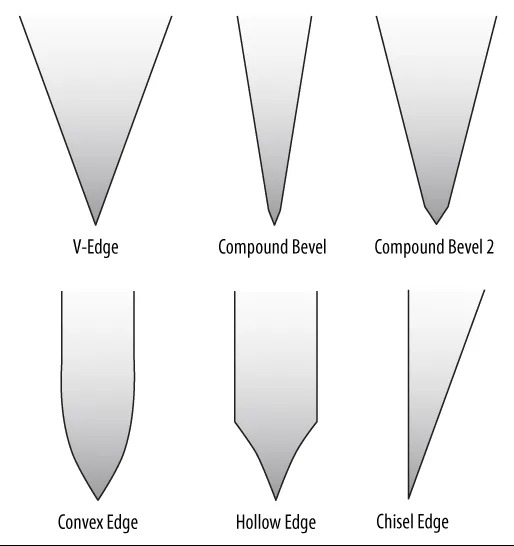
As earlier mentioned, the tang’s edge influences your cutting angle and, by extension, the lifespan – how long the blade stays sharp and on the hilt. The logic behind this is simple – the fuller the tank, the heavier your meat cleaver because it adds to the weight.
However, it equally gives the meat cleaver balance, thus holding the blade firmly inside the handle and bearing the brunt of the force when the user swings. There are three standard designs of tang edge, namely;
Single Bevel
The Single Bevel Meat Cleaver is the most popular design because it’s a regular blade with a rounded edge that progresses into a smooth angle. Its angle makes it easy to use and sharpen, earning it a second name – Chisel Edge. It’s typically made in America.
Double Bevel
As the name suggests, the double bevel meat cleaver has a tapered edge on each side of its tang, forming a V-shape. Its double-edged design makes it twice as efficient as a single bevel meat cleaver. This design is common in Europe, especially in French restaurants.
Convex Edge
Convex edge meat cleavers have a single-sided edge similar to the single bevel design but without the rounded edge. This design is indigenous to the Asian region spanning from China to Japan, and they use it for everything.
Antique Meat Cleaver Identification
On the surface, the meat cleaver looks like the vegetable cleaver, but you can spot the slight differences upon closer inspection. This butcher’s knife has a heavy and sharp blade attached to a firm spine made for cutting through tough meat.
The spine increases the blade’s weight, but it also allows you to put more pressure (by pressing down with your palm) on it while cutting.
The Weight
A meat cleaver has a balanced weight in relation to its length and height, meaning the longer a knife, the heavier its composition.
The Blade Size
When it comes to meat cleavers, the thicker, the better, should be your mantra because that’s why they stand out from other types of knives. It typically has a rectangular blade with a hole on the top edge and spans 6” to 8” long.
The Blade Material
Meat cleavers generally have metal blades, although the quality differs from stainless steel to ceramic. Here is a list to help you choose, including the pros and cons.
Carbon

The blade mixes carbon with iron making it easy to sharpen, albeit at risk of early rusting.
Ceramic
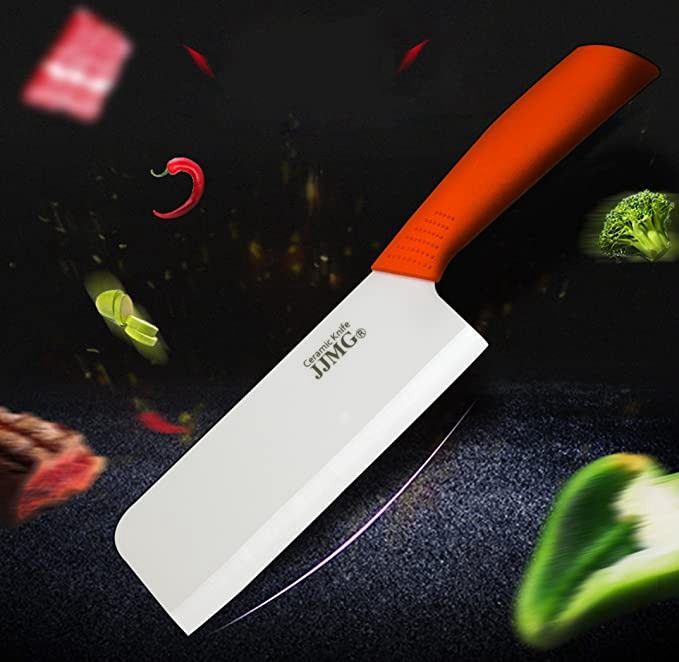
This is perhaps the hardest blade to sharpen is ceramic because of its hard texture despite its lightweight feel. The best thing about ceramic tangs is their long-term lifespan regardless of the fortune you might fork out at purchase.
Damascus Steel
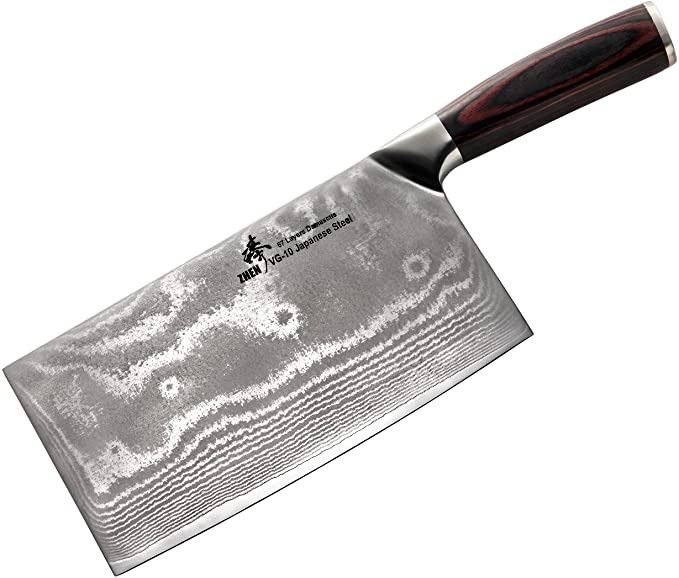
Due to stainless steel’s popularity, it’s easy to forget other types, such as the Damascus steel, otherwise called the laminated steel. It’s another beautiful blade that blends alloys into a blade, causing it to have curly lines.
The selling point for this blade is its aesthetic appeal and welded assembly making it perfect for heavy-duty cuts.
Titanium
No, Titanium isn’t strictly for bullets, nor does it refer to the popular chart-topping Sia song. It’s a great material with a long-lasting shelf-life and less risk of corrosion.
Stainless Steel
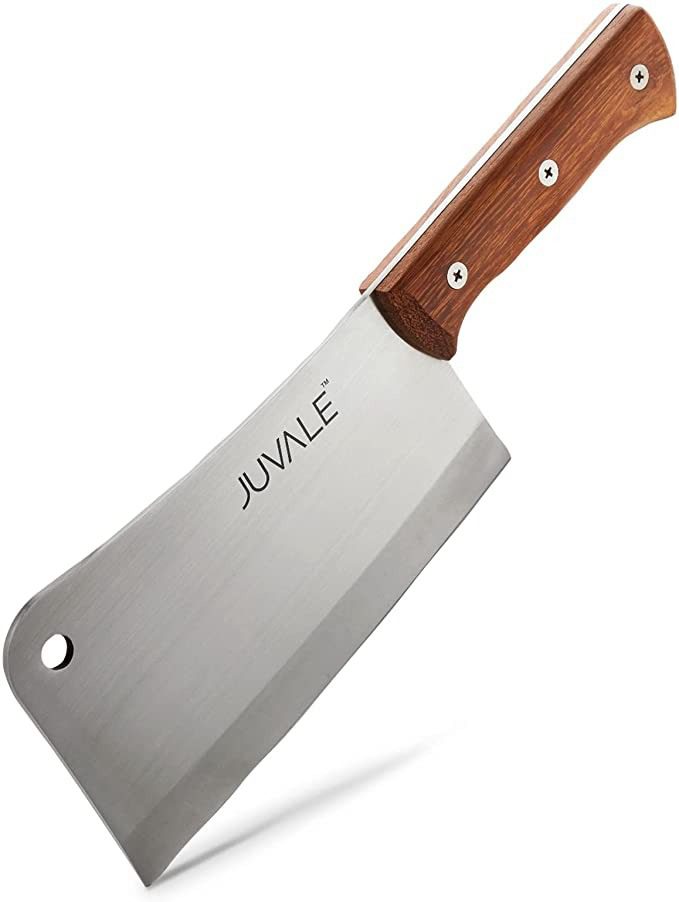
Stainless Steel blade is unarguably the most popular material used in forging kitchen knives since the late 20th century. Its anti-rust technology makes it the most durable material yet easy to sharpen and clean.
How sharp is the blade?
Very sharp. The essence of a meat cleaver’s blade being thick is to reduce the strain on your muscles when cutting, and the same goes for its sharpness. Its blade angle also has a specific design that makes it thin out towards the spine.
With its differing thickness, you can move your hands forward or backward depending on the angle and size you intend to cut.
Is the Tang Extended or Partial?
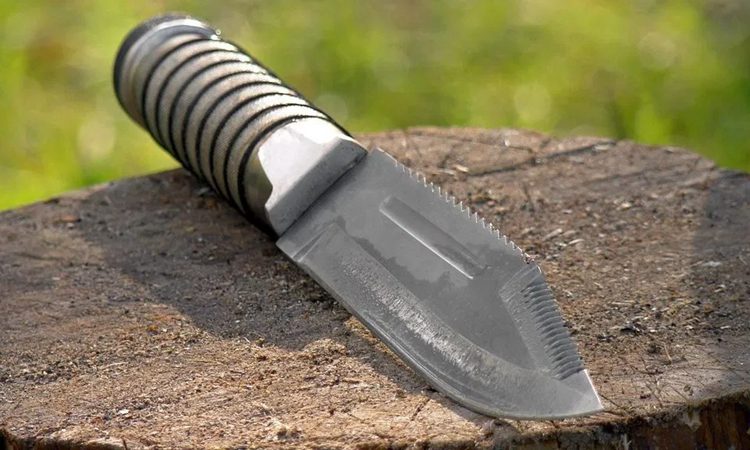
What’s the difference, you may ask? Well, it comes down to versatility. A meat cleaver has a full tang (blade) when it reaches the handle, while it’s partial when only a part enters the handle causing an uneven shape on the rectangle.
Experts advise that beginners and regular meat cleaver owners stick to using full tang blades while leaving the fancy partial tang to the professionals. Not only is it safe, but also easier to navigate, unlike the other design, which requires professional skill.
Also, the tang’s angle influences the lifespan of your meat cleaver because it informs the way you cut. Read more on this below.
Some Popular Antique Meat Cleaver Brands
Dexter-Russell
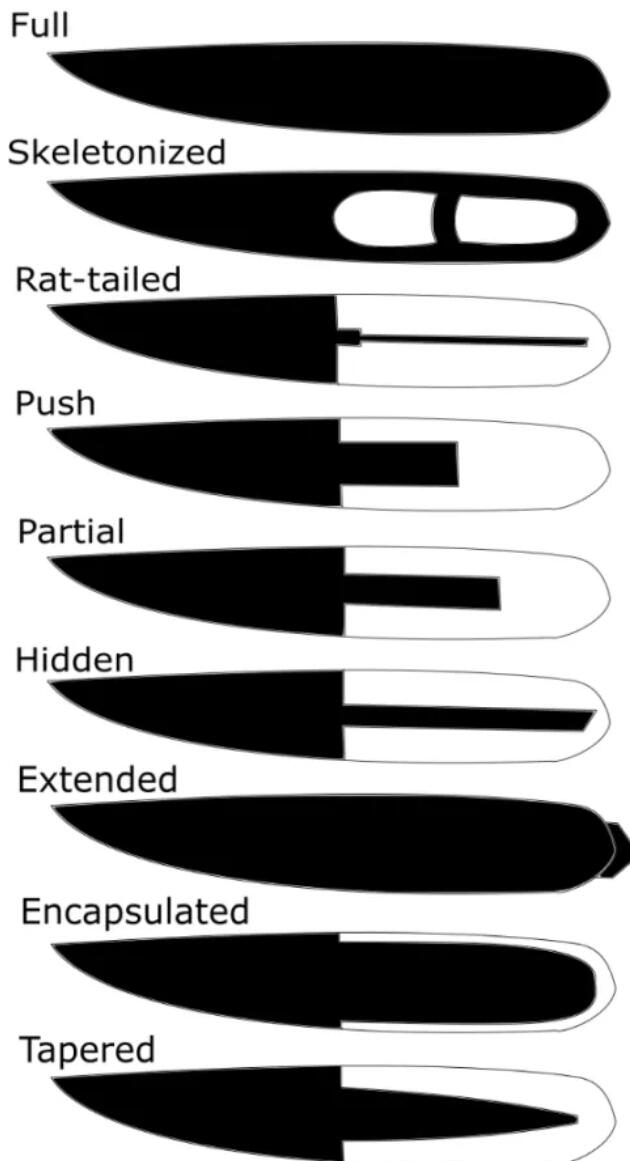
Dexter-Russell incorporated an American brand that started as Harrington Cutlery Co. in 1818. It holds the record as the first cutlery company in the USA and has become a household name 200 years later.
Dexter meat cleavers have the brand’s name engraved on the blade and the handles.
F. Dick
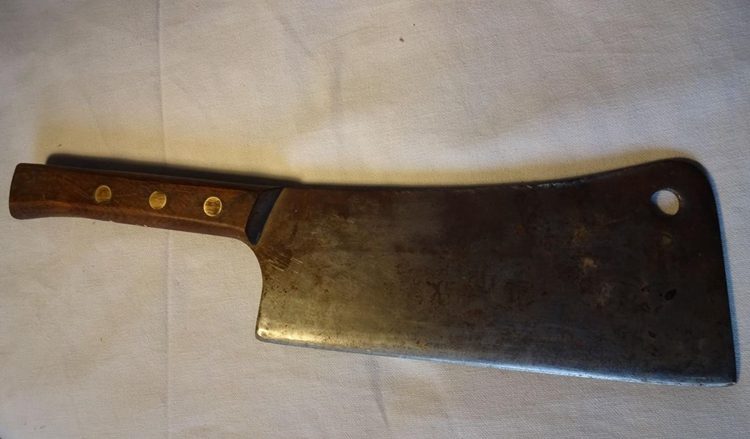
Established in 1778 by Johann Friedrich Dick, F. Dick wasn’t always a knife manufacturer. It wasn’t until 1873 that the German plant produced its first sharpening steel. In 1905, F. Dick produced its first cleaver – the AJAX series. They sell at an average of 100 euros.
Henckels
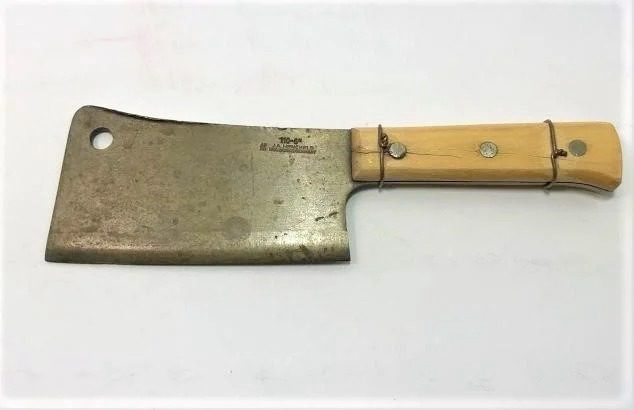
Peter Henckels created the German brand Zwilling J.A. Henckels in 1731 and remained one of the most sought-after brands worldwide. Henckel’s meat cleavers have full tangs with blades forged out of high-carbon stainless steel.
Shun Cutlery
In 1908, Shun revolutionized kitchen knives by introducing a lightweight design inspired by Japanese cutlery. Eventually, it evolved into the now known Kai Group and remained one of the USA’s most popular high-end knife-making brands.
Its years of success haven’t watered down the uniqueness of its design as the designer handcrafts each Shun piece.
Wüsthof
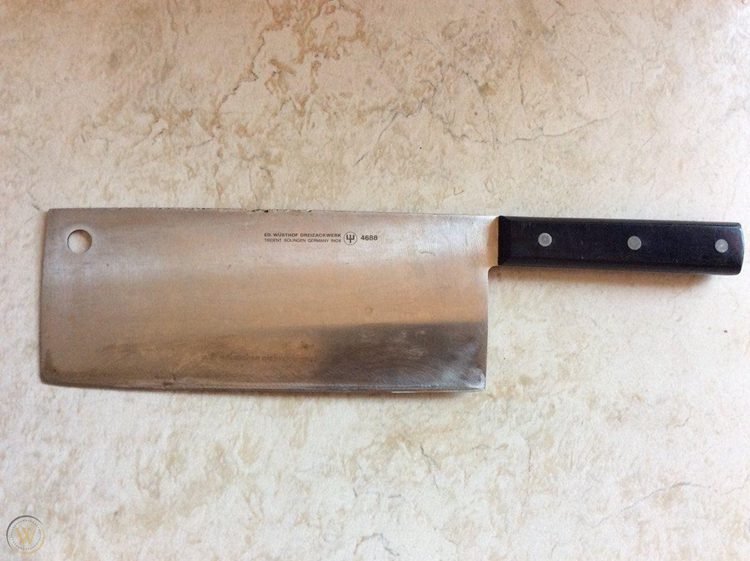
Johann Abraham Wüsthof built his eponymous company, Wüsthof, in 1814 during the thick of the Napoleon war in Europe. What started as a scissors-making brand soon expanded into a knife manufacturing company, making it a household name.
Are Antique Meat Cleavers Worth Anything?
Even though we highlighted the popularity of meat cleavers between chefs and cooking enthusiasts, it doesn’t hurt for a regular homemaker to own one. Because it’s a kitchen staple, the meat cleaver will not tear your pockets, although you’ll dig deep for high-end brands.
You can get a regular meat cleaver for a fee of $20 to $50, while the luxurious brands sell at higher values between $100 to $250, like with any other product, certain factors such as materials and composition influence the bottom line.
Meat Cleavers with stainless steel blades are the most expensive models because of the anti-rust technology and their sharp cut. On the flip side, iron blades make the least market value.
Current market value
New meat cleavers sell between $9 to $100 on the average on Amazon, while the antique and vintage pieces sell at higher values on auction sites and secondary retail sites.
Hot tips for determining the value
Determining the value of a meat cleaver is a straightforward process since it’s mainly the material and design that matter the most. Ceramic and stainless steel blades have the highest value on the market, while metal blades are the lower values.
Factors Affecting the Value of Antique Meat Cleavers
The general factors that affect antique tools values also apply to meat cleavers. They are;
Age, Brand, Design, Material, and historical importance.
How old is your meat cleaver?
The logic behind antique meat cleavers being valuable is because most tools made in the golden era of manufacturing – the 17th to early 19th century – used the highest quality materials and were mostly handmade.
With the introduction of mass production by the 20th century, the quality dropped, but household brands maintained theirs hence the second factor.
Older meat cleavers are not intrinsically valuable despite what you’ve heard or read. So, before you rush to auction your antique meat cleaver, consider the other value-affecting options.
What brand is your meat cleaver?
Buyers and Collectors rely on notable brand names because they’re tested and trusted. There’s less risk for a high-quality brand to malfunction than an unknown name, and even if it does, you’re assured of a means of reparation through their helplines.
How comfortable is the meat cleaver to use?
Meat cleavers with ergonomic handles and streamlined designs are more coveted than others. The risks of using a meat cleaver are already high, especially for new users, so you should get ones with secure handles that are less susceptible to dissembling.
The Material is a Wild Card
As we mentioned under the hot tips for determining value, stainless steel and ceramic blades are some of the most expensive designs. Also, meat cleavers with wooden handles are affordable except for the rare woods like Oak, Sandalwood, Mahogany, and Ziricote.
That’s why specially commissioned meat cleavers would sell for significantly more than any other regular brand.
Restoration of a Rusted Meat Cleaver
Watch the video below to see how you can make the rust on your meat cleaver blade disappear.
Imagine how frustrating getting a valuable antique meat cleaver riddled with rust can be for a collector. Well, don’t be discouraged because there’s a lot you can do to salvage the tool. For some hobbyists, keeping it intact gives them an aesthetic appeal.
However, if you fall within the category of people who want to use their meat cleavers for something other than decoration, here’s a solution for you.
Things to Get
- White Vinegar/Baking Soda
- Steel wool or Wire Brush
- Dishwashing liquid or soap
- Soft clean towel
Restoration with White Vinegar
Soak your rusted blade in a bowl of ¾ full white vinegar overnight or for 8 hours. Once the time is up, scrape off the rust (by then, the vinegar’s reaction will soften the rust) using the wire brush or steel wool, depending on your preference.
Wash the vinegar clean with dishwashing soap in warm water and towel dry.
Restoration with Baking Soda
If you don’t have white vinegar, surely you can access baking soda. However, note that it works best with light rusts on thin metal; otherwise, we advise that you choose the former option. Mix the baking soda with lukewarm water into a paste (not thick nor thin).
Swat the paste on the blade and leave to react for an hour or two. Scrape off the paste (the rust will come off too) and rinse under tap water. Clean the blade.
For more tips, check Architectural Digest.
How restoration affects the value
Some collectors believe restoration diminishes the value of antique meat cleavers because of the chemical reaction on the blade and years of sharpening chipping away. If you’re looking to resell, it’s best to leave it as is for the new owner to make that decision.
Maintenance of a Meat Cleaver
Most present-day meat cleaver blades are made of stainless steel. However, the same isn’t typical of antiques. Ensure you store your item in a cool/dry place like your wall utensil strip, cabinet, strainer basket, holder, or tray.
The hole on its top edge is also a good way of maintenance by hanging it on the hook – it’s not a decorative feature. Modern strips also have magnets designed to hold meat cleavers in place, so you can buy one in your local store.
Sharpening your antique meat cleaver
Meat cleavers don’t need extra sharp edges like other kitchen knives, so be careful when sharpening with a grinder. Also, note that the tang edge determines your grinding degree because each region has a different shape and, by extension, standard.
Asian Convex Edge tangs require less grind at 15 – 18 degrees, whereas Western Single Bevel meat cleavers sharpen at a higher degree of 20 – 22.
Does the Handle Matter?
Of course, it does. You don’t want a meat cleaver without a firm grip risking an accident. Here are the things you should look for when choosing.
Ensure the handle is ergonomic, that is – easy grip technology. Something that fits into your hands comfortably without slipping or you struggling. Avoid cheap wood, even though it’s one of the cheapest options because it gets messy. Instead, you can buy steel variations, quality wood, or strong plastic.
Final Words
Meat cleavers are a necessity for elite cooking and their affordability leaves no room for excuses. On the other hand, antique meat cleavers are relatively pricey since you’ll part with no less than $100 for a quality brand.
Here’s a few tips to help you pick out the perfect antique meat cleaver;
- Look for high-quality wood
- You can always restore rusted blades
- Full tangs are the best for unskilled users
FAQs
Q: What is a meat cleaver used for?
A: Meat Cleavers are primarily used for cutting tough meat like Pork and steak with a sharp edge, while the wide blade is good for crushing vegetables like garlic and squash.
The blade’s design is meant for easy cuts even though you hammer down with force when cutting with a meat cleaver.
Also, note that bone in this context doesn’t mean solid or hard, as you’d need a more capable tool like a bone saw to rip that apart.
Q: Why is there a Hole on the blade?
A: The hole on the blade is meant for hanging the meat cleaver on an overhead or wall hook. It gives the user easy access to the tool when cooking and also prevents it from early bluntness. It also reduces friction by letting air through during the swinging motion.
Q: Why is the Meat Cleaver important?
A: Imagine cutting through frozen thick meat, cartilage, and joints easily without hurting your arms from exerting energy. That feeling of contentment and stress-free cooking are the reasons for getting a meat cleaver. So, even though all kitchen knives can get the job done, albeit with a little more struggle here or there, wouldn’t you rather have it easy?
Q: What is the difference between a Meat Cleaver, a Vegetable Cleaver, and a Butcher’s Knife?
A: The butcher’s knife cuts only meat while the meat cleaver dismantles connective tissue and joints. In the same way, a vegetable cleaver has thinner blades meant for chopping fruits, leaves, and soft (deboned) meat.
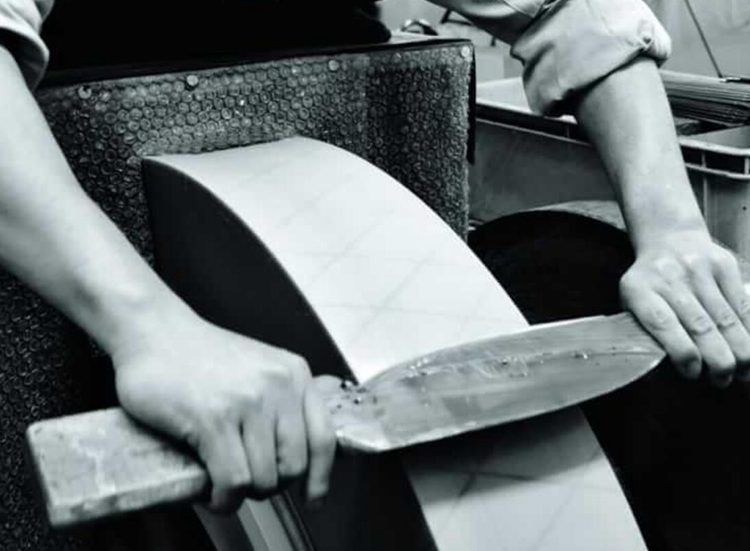






![Vintage Schwinn Bikes: [Types, Identification, and Values]](https://www.txantiquemall.com/wp-content/uploads/2022/05/5.-Schwinn-1967-Ramshorn-Fastback-Stingray-Sky-Blue-vtg-600x450.jpg)
